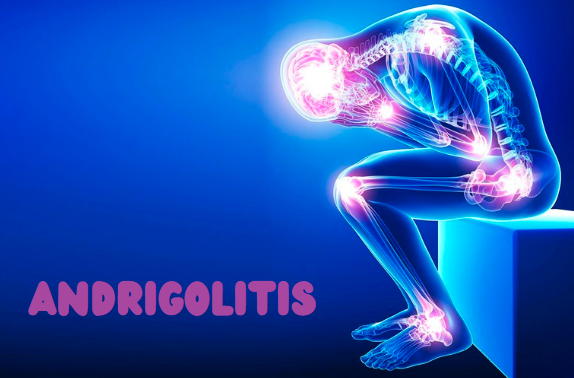Understanding Andrigolitis: A Comprehensive Exploration of a Mysterious Condition
Introduction
In recent years, a term called “andrigolitis” has surfaced in discussions about joint pain and arthritis-like symptoms. Although it is not a medically recognized condition, it has captured the attention of people experiencing unexplained joint discomfort, sparking conversations and online searches in the USA and beyond.
This article will delve deep into the concept of andrigolitis, exploring its origins, possible symptoms, and the reasons behind its growing popularity. We will also provide insights and analyses that go beyond existing information, offering a thorough examination of this emerging topic.
What Is Andrigolitis?
The Emergence of Andrigolitis
Andrigolitis is a term that has recently appeared in various online forums, blogs, and health-related discussions. Despite its prevalence in these discussions, it is important to note that andrigolitis is not recognized by the medical community as an official diagnosis or medical condition. The term seems to have been coined to describe a set of symptoms that closely resemble those of arthritis but with distinct differences that set it apart.
Symptoms Associated with Andrigolitis
People who identify with the term andrigolitis typically report experiencing symptoms similar to those of arthritis, such as joint pain, stiffness, and swelling. However, there are key differences:
- Localized Pain: Unlike traditional arthritis, which can affect multiple joints throughout the body, andrigolitis is often described as affecting specific joints or areas, such as the knees, elbows, or hands.
- Intermittent Symptoms: Another distinguishing feature is the intermittent nature of the symptoms. Individuals with andrigolitis report that their joint pain and discomfort come and go, with periods of relief in between flare-ups.
- No Visible Inflammation: While arthritis is often accompanied by visible signs of inflammation, such as redness and swelling, those with andrigolitis may not exhibit these outward symptoms, making it difficult for healthcare professionals to diagnose the condition based on physical examination alone.
Possible Causes of Andrigolitis
Given that andrigolitis is not a medically recognized condition, the causes of these symptoms are not well understood. However, there are several theories that have been proposed:
- Psychosomatic Factors: Some experts believe that the symptoms of andrigolitis may be psychosomatic, meaning they are influenced by psychological factors such as stress, anxiety, or depression. This could explain why the symptoms are intermittent and why there is often no visible inflammation.
- Undiagnosed Arthritis: It is possible that individuals experiencing andrigolitis are actually suffering from an early or mild form of arthritis that has not yet been properly diagnosed. In some cases, the symptoms may be too subtle to detect through standard diagnostic methods.
- Environmental Triggers: Another theory suggests that environmental factors, such as changes in weather, diet, or exposure to certain chemicals, may trigger the symptoms of andrigolitis in susceptible individuals.
- Infectious Agents: Although less common, there is a possibility that andrigolitis could be related to an underlying infection, such as a viral or bacterial infection, that affects the joints in a way that mimics arthritis.
The Role of Online Communities
One of the reasons andrigolitis has gained traction is the role of online communities and forums where individuals share their experiences and seek advice. These platforms provide a space for people who feel that their symptoms do not fit neatly into the categories of existing medical conditions to connect with others who may be going through similar experiences.
Why Andrigolitis Is Not Recognized by the Medical Community
Despite its growing popularity in online discussions, andrigolitis is not recognized by the medical community for several reasons:
- Lack of Scientific Evidence: There is currently no scientific research or clinical studies that validate the existence of andrigolitis as a distinct medical condition. Without empirical evidence, it is difficult for the medical community to acknowledge andrigolitis as a legitimate diagnosis.
- Overlap with Other Conditions: The symptoms associated with andrigolitis overlap significantly with those of other recognized conditions, such as osteoarthritis, rheumatoid arthritis, and fibromyalgia. This makes it challenging to differentiate andrigolitis as a separate entity.
- The Power of Perception: It is important to consider the role of perception and the placebo effect in the development of new medical terms and conditions. In some cases, individuals may adopt a new term like andrigolitis to describe their symptoms, which can influence how they perceive and experience their pain.
A Deeper Dive: Analyzing the Phenomenon of Andrigolitis
The Psychology Behind Andrigolitis
The psychology of pain is a complex and multifaceted topic. Pain perception is influenced by a variety of factors, including emotional state, past experiences, and cultural beliefs. In the case of andrigolitis, it is possible that individuals are experiencing a form of pain that is amplified by psychological factors. For example, stress and anxiety are known to exacerbate physical pain, and this could be a contributing factor for those who identify with andrigolitis.
The Impact of Self-Diagnosis
The rise of the internet has made it easier than ever for individuals to research their symptoms and arrive at their own conclusions. While self-diagnosis can empower individuals to take control of their health, it can also lead to confusion and misinformation. In the case of andrigolitis, self-diagnosis may result in people attributing their symptoms to a condition that does not have a clear medical basis.
The Influence of Social Media
Social media platforms have played a significant role in spreading awareness of andrigolitis. Hashtags, posts, and discussions about andrigolitis have gained traction, leading to a sense of community among those who believe they are experiencing this condition. However, the downside of this is that social media can also perpetuate myths and misinformation, as individuals share unverified information and personal anecdotes.
The Search for Validation
For many individuals, the search for a diagnosis is also a search for validation. When doctors are unable to provide a clear diagnosis, patients may feel frustrated and invalidated. In such cases, finding a term like andrigolitis that seems to explain their symptoms can be comforting, even if it is not recognized by the medical community. This quest for validation can drive people to embrace new and emerging terms that resonate with their experiences.
The Medical Community’s Response
The medical community’s response to conditions like andrigolitis is often cautious. Without scientific evidence to support the existence of andrigolitis as a distinct condition, healthcare professionals are unlikely to endorse it. Instead, they may focus on ruling out other possible causes of the symptoms and providing treatment based on established medical knowledge.
The Importance of Comprehensive Evaluation
For individuals experiencing joint pain and arthritis-like symptoms, it is essential to undergo a comprehensive medical evaluation. This should include a thorough physical examination, medical history, and diagnostic tests such as blood work and imaging studies. By ruling out other possible causes of the symptoms, healthcare providers can offer a more accurate diagnosis and appropriate treatment plan.
Managing Symptoms of Andrigolitis
Lifestyle Changes
For those who believe they are experiencing symptoms of andrigolitis, making certain lifestyle changes may help alleviate discomfort:
- Regular Exercise: Engaging in low-impact exercises such as swimming, walking, or yoga can help maintain joint mobility and reduce stiffness.
- Healthy Diet: A diet rich in anti-inflammatory foods, such as fruits, vegetables, and omega-3 fatty acids, may help reduce joint pain.
- Stress Management: Practicing stress-reducing techniques such as meditation, deep breathing, or mindfulness can help manage the psychological factors that may contribute to pain.
Pain Management Techniques
In addition to lifestyle changes, there are various pain management techniques that can help manage symptoms:
- Over-the-Counter Medications: Nonsteroidal anti-inflammatory drugs (NSAIDs) such as ibuprofen can help reduce pain and inflammation.
- Physical Therapy: Working with a physical therapist can help improve joint function and alleviate pain.
- Hot and Cold Therapy: Applying heat or cold to the affected joints can provide temporary relief from pain.
Seeking Medical Advice
If you are experiencing persistent joint pain and discomfort, it is important to seek medical advice. A healthcare provider can help determine the underlying cause of your symptoms and recommend appropriate treatment options.
The Role of Alternative Therapies
Some individuals may explore alternative therapies to manage their symptoms. These can include acupuncture, chiropractic care, or herbal supplements. While some people find relief through these methods, it is important to approach alternative therapies with caution and consult with a healthcare provider before starting any new treatment.
Conclusion
Andrigolitis is a term that has emerged in recent discussions about joint pain and arthritis-like symptoms, though it is not recognized by the medical community as a distinct condition. The symptoms associated with andrigolitis closely resemble those of arthritis, but with key differences such as localized pain, intermittent symptoms, and the absence of visible inflammation. While the causes of these symptoms are not well understood, they may be influenced by psychosomatic factors, undiagnosed arthritis, environmental triggers, or infectious agents.
The rise of andrigolitis in online discussions and social media reflects a broader trend of self-diagnosis and the search for validation among individuals experiencing unexplained symptoms. While the medical community remains cautious about recognizing andrigolitis as a legitimate condition, it is important for individuals to seek comprehensive medical evaluations and evidence-based treatments.
In the absence of scientific evidence to support the existence of andrigolitis, those experiencing joint pain should focus on managing their symptoms through lifestyle changes, pain management techniques, and medical advice. As with any health concern, it is essential to approach new and emerging terms with a critical eye and prioritize evidence-based care.
FAQs About Andrigolitis
Q: Is andrigolitis a real medical condition?
A: No, andrigolitis is not recognized by the medical community as a real medical condition. It is a term that has surfaced in online discussions but lacks scientific evidence and validation.
Q: What are the symptoms of andrigolitis?
A: The symptoms of andrigolitis are similar to those of arthritis, including joint pain, stiffness, and discomfort. However, the symptoms are often localized, intermittent, and may not be accompanied by visible inflammation.
Q: How is andrigolitis diagnosed?
A: Since andrigolitis is not a medically recognized condition, there are no specific diagnostic criteria for it. Individuals experiencing symptoms should seek a comprehensive medical evaluation to rule out other possible causes of their symptoms.
Q: Can andrigolitis be treated?
A: Treatment for symptoms associated with andrigolitis can include lifestyle changes, pain management techniques, and medical advice. Since it is not a recognized condition, treatment is typically based on managing symptoms rather than addressing a specific diagnosis.
Q: Should I be concerned if I think I have andrigolitis?
A: If you are experiencing persistent joint pain or discomfort, it is important to consult with a healthcare provider. They can help determine the underlying cause of your symptoms and recommend appropriate treatment options.






